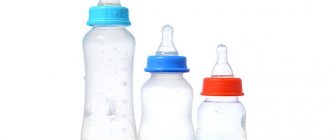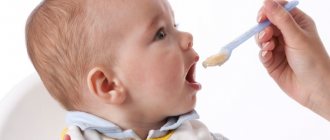Is this an allergy?
First of all, it is important to understand the nature of the rashes that appear on your baby’s body. At first glance, redness, irritation and rash clearly indicate problems in the body. However, there is a rash that is completely natural and is not something to be afraid of.
We are talking about the so-called “newborn acne,” which appears on the skin in the first month of your baby’s life. Its appearance is explained by the following: the baby’s hormonal levels begin to return to normal, and the mother’s hormones, which were obtained during pregnancy, leave the child’s body. During the process of this restructuring, a small reddish rash appears on the body - most often on the face, sometimes the rash is localized on the upper part of the body.
After a maximum of a month, such a rash goes away on its own. The only thing you shouldn’t do is squeeze out small pimples and try to “remove” them with a cotton swab.
If the redness does not go away for a long time and is accompanied by itching that bothers the baby, or the rashes become profuse, you should consult a pediatrician. Perhaps this is already a true allergy.
How does an allergy to formula manifest in infants?
The reaction to an allergen manifests itself through different systems of the body. Here's what food allergy symptoms look like:
- On the skin
: redness that starts on the face and spreads throughout the body, small blisters, peeling - From the digestive system
: regurgitation, loose stools, especially green, constipation, bloating, colic - From the respiratory system
: difficulty breathing, cough, wheezing
How long does it take for an allergy to the mixture to appear?
How quickly the disease makes itself known depends on the health of the child. In some babies, the first signs of an allergy appear immediately after feeding. For others, the allergen will manifest itself only after a few days, when it accumulates in the body. In any case, you should immediately contact a specialist who will make a diagnosis and prescribe adequate treatment.
Signs of an allergic rash in a baby
In children under one year of age, allergic rashes are localized on the cheeks, neck, arms (forearms) and buttocks. At first - usually short-term, just a few hours - the allergy looks like red spots, gradually merging into one spot. The skin in these places swells slightly and swells.
True allergies are not limited to rashes. Symptoms include redness of the skin, roughness and dryness. The appearance of the rash is accompanied by itching, which worries the child. The baby becomes irritable, sleeps poorly, and may refuse to eat. In some cases, allergies are accompanied by changes in the gastrointestinal tract.
When emergency help is required
If an allergic rash in a newborn is accompanied by lacrimation, nasal congestion, and swelling on the face, you should immediately call an ambulance.
Symptoms may indicate angioedema, the development of which causes swelling of the larynx and tongue, leading to suffocation.
First aid and treatment
If children develop an allergic rash on their skin, it is strictly forbidden to squeeze pimples or open blisters. It is necessary to explain to the child that it is also forbidden to scratch the sores.
If he is still too small, make sure that he does not touch the wounds with dirty hands. He can get an infection, and this will only worsen his condition.
Treatment of rashes in children is selected depending on the type of disease. Parents who do not know how to treat allergic rashes in children should not select medications on their own.
Why does a baby develop an allergic rash: looking for reasons
The long-established belief is that an allergic rash in a newborn occurs solely due to its diet, i.e. due to mother's milk, erroneously. This is certainly one of the reasons. However, other possible allergens should also be excluded.
Factors that indicate that a child is prone to allergies are:
- Having relatives who suffer from allergies, especially if it is the father or mother of the baby.
- Taking antibiotics by a child or mother.
- Artificial formula feeding.
- Complications of pregnancy due to maternal illnesses during this period.
In all these cases, the newborn is most likely predisposed to allergies. Following simple preventive measures will help prevent its occurrence.
- Clothes for a newborn should be of high quality, made from natural materials. The exception is woolen items, which can cause skin irritation.
- You need to wash your clothes thoroughly, using a special powder. An allergic rash in a baby can be a banal reaction to household chemicals. The same applies to parents’ clothing and other fabrics with which the child comes into contact.
- Check the baby cosmetics you use. It may contain components that can cause irritation. It’s better to choose reliable means. The La Cree line includes cosmetics for the care of newborns: foam shampoo for children from birth, cleansing gel and emulsion. All products have a natural composition and do not contain hormones.
- Nursing mothers should adhere to a special diet.
- An allergic rash in a formula-fed baby is no less common. In this case, the irritant is the proteins contained in infant formula. There is nothing more natural in nature than breastfeeding a baby. Mother's milk is in itself the best prevention against allergies.
What to do when an allergic rash appears in an infant?
If you cannot find the allergen on your own, consult a doctor. The pediatrician will be able to determine the cause of the rash.
Under no circumstances should you self-administer medications. If necessary, drug treatment will be prescribed.
During the treatment period, pay attention to any little things:
- Carefully monitor your baby’s hygiene and skin condition. If improperly cared for, diaper dermatitis may appear in the diaper area.
- Try not to dry out your baby's skin.
- Change wet clothes in a timely manner, do not wrap the child too tightly if it is hot indoors or outdoors - otherwise, the child may develop heat rash.
- Use special household chemicals for washing your clothes and children’s clothes, cleaning the children’s room - it is best to choose products marked “hypoallergenic”.
- It is best if there are no pets in the house that can cause allergies.
- Monitor your diet and your baby's nutrition. A nursing mother should not eat peas, beans, beets, peaches, apricots, bananas, eggs, fish, seafood, carrots, tomatoes, strawberries, citrus fruits, pineapples, melon, coffee, chocolate, mushrooms, nuts, honey, and possibly products containing cow's milk protein.
Basic recommendations for the treatment of food allergies in infants:
- It is necessary to follow a diet that prevents contact with allergens. For this diet, special products are used that have an extremely low content of allergens or do not contain them at all.
- You should adhere to a strict diet when artificially feeding.
- Only a doctor can choose a specific product that is suitable for your child!
- Your doctor will determine the duration of dietary therapy for food allergies in infants. It is important to give the immune system a “rest” from allergens and recover, and then properly prepare the child to develop resistance to allergens.
Allergic rash in newborns: how to treat
Once the allergen has been found and excluded, all your actions should be aimed at relieving the unpleasant symptoms that accompany the allergic rash.
Treat the rash areas with a non-greasy hypoallergenic cream. Pharmacy cream "La-Cri" is a natural cosmetics that does not contain hormonal components, dyes or fragrances. The cream perfectly removes peeling and redness, promotes healing and relieves itching, including on the legs.
It is important that La-Cri products are approved for use by infants - this is confirmed by a state certificate and numerous studies. The brand’s medicinal cosmetics are sold only in pharmacies, which is also a sign of the product’s quality. “Skin like a baby’s” - how often do we hear this expression! Indeed, the skin of babies in videos and on advertising posters is ideal, but in reality, parents often encounter allergic rashes in their newborns. What do moms and dads need to know so as not to panic and help the baby?
- Nursing mothers should adhere to a strict diet: exclude chocolate, milk, nuts, honey, citrus fruits, strawberries, tomatoes and other possible allergens. The nutritional system is usually developed by a pediatrician who observes the child.
- An allergic rash in a formula-fed baby is no less common. In this case, the irritant is the proteins contained in infant formula. The solution is simple: choose a different mixture (medicinal) for the baby.
- Clothes for newborns should be of high quality, made from natural materials. The exception is woolen items, which can cause skin irritation.
- You need to wash your clothes thoroughly, using a special powder. An allergic rash in a baby can be a banal reaction to household chemicals.
Allergy to hypoallergenic mixture
Hydrolyzed mixtures are called hypoallergenic - those where milk protein is split into amino acids and peptides, which are easily absorbed by the body and in most cases do not cause an undesirable reaction. They are prescribed in cases of severe allergies. They are bitter, and babies eat them reluctantly.
However, an undesirable reaction can also occur to a hypoallergenic mixture. That is why only a pediatrician should recommend the mixture and select treatment in case of allergies.
What to do if an allergic rash appears in a newborn?
- Consult your pediatrician to determine the cause of the rash. Never give medications or antibiotics without a doctor's prescription.
- Do not overdry the baby's skin. Treat the rash areas with a non-greasy hypoallergenic cream. Pharmacy cream "La-Cri" is a natural cosmetics that does not contain hormonal components, dyes or fragrances. The cream perfectly removes peeling and redness, promotes healing and relieves itching, including on the legs. It is important that La-Cri products are approved for use by infants - this is confirmed by a state certificate and numerous studies. The brand's medicinal cosmetics are sold only in pharmacies, which is also a sign of the quality of the product.
How to correctly identify allergens
If the baby develops unpleasant symptoms, it is necessary to contact a pediatrician as soon as possible, who, if necessary, will refer the baby to an allergist-immunologist for a more detailed examination.
Tiunova Elena
K.M.N., pediatrician of the highest category, nutritionist
“It is important to keep a food diary where a nursing woman records the foods she eats and the baby’s nutrition if he has already been introduced to complementary foods and analyze the connection and appearance of certain allergy symptoms.”
At the appointment, the doctor will collect an anamnesis and, if necessary, prescribe skin testing or laboratory blood tests to determine immunoglobulins E and food antigens. In some cases, it is possible to identify the allergen without testing by eliminating potentially provoking factors.
Clinical researches
Clinical studies have proven the effectiveness, safety and tolerability of the products. The products are suitable for daily care of children's skin with mild to moderate forms of atopic dermatitis and during remission, accompanied by a decrease in the quality of life of patients.
The properties of the products are confirmed by clinical studies, during which it was found that La-Cri cream for sensitive skin:
- reduces itching and irritation;
- relieves skin redness;
- moisturizes and gently cares for the skin.
Based on the results of clinical studies, the product packaging contains information that the creams are recommended by the St. Petersburg branch of the Union of Pediatricians of Russia.
Sources:
- Kamasheva G.R., Khakimova R.F. Valiullina S.A., Methods for assessing the severity of atopic dermatitis in young children, Dermatology journal, 2010
- Kovyazina N.A., Fedosimova N.A., Illek Ya. Yu. Diagnosis of atopic dermatitis in young children, Vyatka Medical Bulletin, 2007
- Smirnova G.I. Managing the course of the disease: atopic dermatitis in children, Russian pediatric journal, 2014
Photos of allergies in children
Photo album on the diseaseWhat types of allergies are there?
Food
Allergies can occur in both bottle-fed and breast-fed newborns. Many scientists note that there is a hereditary predisposition to allergies, therefore, if a child’s relatives suffer from this problem, then it can also manifest itself in the baby.
The risk of developing an allergic reaction in infants can be increased by unreasonable supplementary feeding in the maternity hospital with formula milk, while the mother has not yet produced her milk. Therefore, breastfeeding consultants do not recommend doing this. They advise putting the baby to the breast more often to stimulate the production of breast milk by the mammary glands.
In most cases, food intolerance and food allergy to formula in newborns is caused by cow's (or goat's) milk protein. Some medications prescribed to a newborn can also cause food allergies.
Contact
In some cases, allergies in newborns appear upon contact with various external factors. Most often, a negative reaction from the body can be caused by:
- dust and mites living in it;
- household chemicals (soap, washing powder, dishwashing and plumbing cleaners);
- pets (an allergic reaction can occur not only to fur, but also to saliva and other biological fluids of the animal);
- plant pollen;
- cosmetic and hygiene products (shower gels, shampoos, parental perfumes, wet wipes, cosmetic oils, creams, etc.);
- toys (some rattles are made of toxic materials and therefore can provoke allergies; it is also advisable to remove soft toys that accumulate dust from a baby who is prone to allergic reactions);
- clothing (poor quality items can cause allergic reactions when in contact with the child’s skin, so it is advisable to purchase clothing that comes into contact with the skin, in soft colors, made from natural fabrics).
Allergies are directly related to the functioning of the immune system, but in many cases it is impossible to determine the exact cause of the reaction in a newborn.











